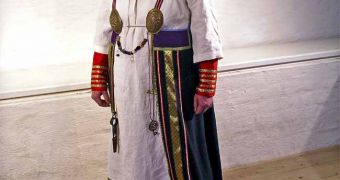Viking men may have been cruel warriors, but their women were really hot. Viking women wore colored-silk gowns embellished with metallic breast coverings and long trains. This type of wardrobe was found in a tomb from the 10th century discovered in the Pskov region (Russia), close to Novgorod.
"Now we can say the pre-Christian dress code was very rich. When Christianity came, the dress was more like that of nuns. There was a big difference," textiles researcher Annika Larsson of Uppsala University, in Sweden, told LiveScience.
This type of female fashion could have applied only to the Swedish Vikings, who made trade journeys east into Russia, Byzantium and Arab world, rather than the Danish/Norwegian Vikings who pillaged western Europe. In fact, a Viking, called Rus, founded a Viking-Slav state that later would turn into Russia.
"Old rituals can live on long after society has changed, but when trade routes are cut off, there's an immediate impact on clothing fashions," Larsson said.
The tomb contained a blue silk dress and ornaments.
"The dress was positioned in the grave as a gift likely to be worn in an afterlife," said Larsson.
Previous data pointed that a Viking woman wore an apron over a linen robe. The apron was made of two rectangular pieces of cloth, and strings on the back panel were fixed in the front with brooches. In the winter, a woolen shawl or sweater was added. But the new discovery shows a Viking woman's dress made of a single piece of fabric with a frontal opening, an outfit which accentuated the breasts through a pair of brooches (clasps).
"It's easy to imagine that the Christian church had certain reservations about clothing that accentuated the breasts in this way and, what's more, exposed the under shift in front. It's also possible that this clothing was associated with pre-Christian rituals and was therefore forbidden once Christianity became established. The changes in clothes over time indicate that medieval Christian fashions hit Sweden as early as the late 900s, a time when new trade routes came into use. Overall, Oriental features in clothing disappeared when Christianity came and the Vikings started to trade with the Christian Byzantine and Western Europe," said Larsson.

 14 DAY TRIAL //
14 DAY TRIAL //